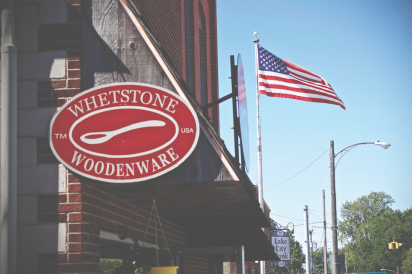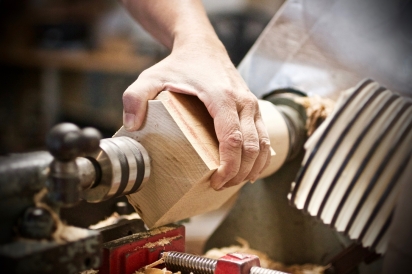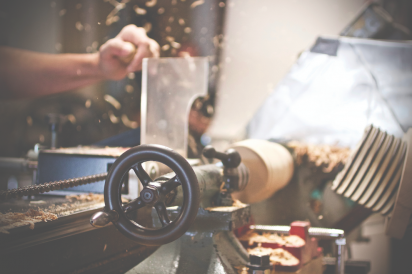Raising the Grain
A small square patch of sandpaper with advice to help “raise the grain” accompanies every purchase at Whetstone Woodenware. It represents company owners John and Debbie Whetstone’s trust that the hallowed task of crafting the piece will continue in the home kitchen, if properly done, for generations.
As consumers, few things are so enduring and entrusted to us to care for, to use, to enjoy and to pass down. Unlike most disposable, temporary and industrially produced kitchenware, Whetstone Woodenware requires a commitment to quality and care.
John Whetstone’s reputation for finely crafted woodenware earned him the trust of the historical market, which in turn helped shape the direction and reach of the company. Whetstone products can be found in more than a dozen museum gift shops across the U.S., including Colonial Williamsburg. In the flagship store located in Silver Lake, Whetstone’s Early American line of kitchenware makes these unique historical forms available to everyone. Focusing his woodworking skills on kitchenware rather than cabinetry allows John to share and ship his creations more easily, preserving historical product forms and inventing new forms to meet diverse contemporary needs.
Whetstone Woodenware’s own history is over 25 years old. Their most awarded and internationally renowned piece is Whetstone’s French rolling pin. Earlier this year The Sweethome Review considered 30 rolling pins and voted Whetstone’s the best: “This tapered pin rolls dough more efficiently than handled pins, works well for rolling both pies and cookies, and is one of the easiest to clean. Plus, it’s good looking and sturdy enough to last a lifetime.”
For John this appreciation of usability, beauty and efficiency is exactly the attention he hoped his product would attract. And this is not the first time the rolling pin was recognized. Celebrating the rolling pin’s exceptional quality, Midwest Living included the rolling pin in its 2012 holiday gift guide.
In addition to developing pieces from historical references, John also draws inspiration for his products from children’s storybooks, the process of production itself and consumer needs. For example, his wok spoon resulted from reshaping a damaged Early American deep-bowled long ladle spoon. In a similar creative leap, inspired by a children’s book illustration of a fishtail-shaped backing on a pipe box, John designed his fishtail cutting boards. The mixture of original designs and historical reproductions allows the Whetstone offerings to address diverse kitchen and dining needs.
John’s attention to every aspect of the production ranges from sourcing Indiana sugar maple from a trusted local lumberyard, Pike Lumber Company (in business since 1904) to shipping the products in appropriate containers to his customers worldwide. In between the steps of sourcing and distribution, John and his team of craftsmen and craftswomen draw, cut, shape, sand, dip, brand and package each product with care. A small example of the workshop’s dedication to quality can be found in their use of ballpoint pens to draw and maintain the consistency of the forms, having discovered the traced shape was affected by the variability of pencil sharpness. Even the scraps are used as mulch or firewood. This attention to wood, tools, packaging and scraps make the products a holistic investment in honoring the material, production and use.
During my visit, I overheard a mother and daughter talking. One had given the other a Whetstone spoon for Christmas. Both were thrilled to be in the store buying more kitchen utensils and talking with co-owner Debbie. The shared love of the product was clearly felt on both sides of the counter. Repeat customers are undeniable evidence of trust and appreciation.
While the enduring quality of Whetstone Woodenware is well documented, the endearing charm of owners John and Debbie has yet to be celebrated. The couple not only enjoy sharing their hard work, but they also enjoy cooking and eating together. They were more than happy to share their own favorite recipes and recipes that would match their products, like a biscuit recipe for the biscuit cutter.
“What do you like to cook?” Debbie asked as she rang up and inspected each of the pieces I had chosen, ready to offer personalized recommendations and to exchange some of the pieces for ones with a more interesting wood grain. I left the showroom with a new set of long-handled spoons perfect to swirl curries, chilies and stews; a biscuit cutter; a set of recipes and inspiration to stir up my own stories.
Will the business of creating an enduring product itself last? Whether the business is family or not, John hopes the next generation of Whetstone products will honor the tradition of quality.
Whetstone Woodenware products are invitations to stir, simmer and ladle family stories. In my own kitchen, I treasure my grandmother’s brass flat slotted spoon she used to fry luchis (a Bengali fried and puffed bread). It even has the indent of her thumb on the handle. What a gift it would be to pass down storied utensils to my daughters. A Whetstone spoon has the rare ability to hold both stories and stew, much like my grandmother’s brass spoon.
Whetstone Woodenware |108 East Main St., Silver Lake | 800.253.3670 | WhetstoneWoodenware.co








